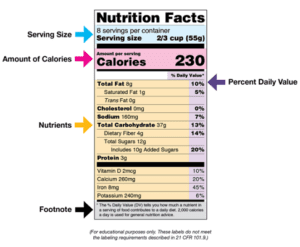 When it comes to making informed choices about the food we consume, understanding nutrition facts labels is crucial. In Canada, nutrition facts labels provide valuable information about the nutritional content of packaged foods. However, deciphering these labels can sometimes be overwhelming. In this blog post, we’ll break down the components of Canadian nutrition facts labels and provide you with the knowledge to make informed decisions about your diet.
When it comes to making informed choices about the food we consume, understanding nutrition facts labels is crucial. In Canada, nutrition facts labels provide valuable information about the nutritional content of packaged foods. However, deciphering these labels can sometimes be overwhelming. In this blog post, we’ll break down the components of Canadian nutrition facts labels and provide you with the knowledge to make informed decisions about your diet.
Serving Size:
 The serving size is a vital element of the nutrition facts label. It indicates the recommended portion size for the product and helps you understand the nutritional content in relation to that specific amount. Pay close attention to the serving size, as it directly affects the values of all other nutrients listed on the label.
The serving size is a vital element of the nutrition facts label. It indicates the recommended portion size for the product and helps you understand the nutritional content in relation to that specific amount. Pay close attention to the serving size, as it directly affects the values of all other nutrients listed on the label.
Calories:
Calories indicate the amount of energy provided by a serving of the food. It’s important to note that the calories listed on the label represent the calories per serving, not for the entire package. This information helps you understand the energy intake associated with a specific portion of the food item.
Macronutrients:
- Fat: This section breaks down the total fat content into saturated and trans fats. Saturated and trans fats should be consumed in moderation, as they can increase the risk of certain health issues such as cardiovascular disease for example (4). Unsaturated fats, such as monounsaturated and polyunsaturated fats, are generally considered healthier options.
- Carbohydrates: Carbohydrates are further divided into total carbohydrates and dietary fiber. Total carbohydrates encompass sugars and starches. Dietary fiber is an essential component of a healthy diet as it aids digestion and helps maintain a balanced blood sugar level (5).
- Protein: Protein is necessary for the growth, repair, and maintenance of body tissues (6). The nutrition facts label provides the amount of protein per serving, giving you an idea of the protein content in the food item.
Micronutrients:

Micronutrients include vitamins and minerals that are vital for overall health. The label typically lists important micronutrients such as vitamin A, vitamin C, calcium, and iron, among others. Keep in mind that the percentages shown next to these micronutrients are based on a recommended daily intake of 2000 calories.
Percent Daily Value (%DV):
The percent daily value indicates how much of a specific nutrient one serving provides compared to the recommended daily intake. For example, if a food item has 15% DV of calcium, it means one serving provides 15% of the calcium needed per day. The % DV is a quick reference to tell you if a food product contains a little or a lot of a certain nutrient: 5% DV or less is a little, 15% DV or more is a lot (7).
Ingredients List:
In addition to the nutrition facts, the ingredients list is an important aspect of Canadian food labels. Ingredients are listed in descending order by weight, with the most significant quantity appearing first. This list helps you identify any potential allergens or ingredients you may want to avoid.
Conclusion:

Understanding Canadian nutrition facts labels empowers you to make informed decisions about your dietary choices. By paying attention to serving sizes, calories, macronutrients, micronutrients, %DV, and ingredients, you can better assess the nutritional value of the foods you consume. Remember, nutrition facts labels are a valuable starting point, but the true power lies in your ability to understand, interpret, and apply this information to your unique needs and preferences. Trust yourself as an informed consumer, and let nutrition facts labels serve as a guide in your journey towards a healthier and more mindful lifestyle.
Connect with us!
To further inquire about your dietary concerns contact us here (insert hyperlink), our team of dietitians and nurse practitioner are here to help answer your questions!
Sources:
- https://www-pennutrition-com.ezproxy.lib.torontomu.ca/KnowledgePathway.aspx?kpid=1583&trid=1555&trcatid=38
- https://www-pennutrition-com.ezproxy.lib.torontomu.ca/KnowledgePathway.aspx?kpid=1583&trid=1927&trcatid=42#3.5
- https://www-pennutrition-com.ezproxy.lib.torontomu.ca/KnowledgePathway.aspx?kpid=1583&pqcatid=146&pqid=26906
- https://www.ncbi.nlm.nih.gov/pmc/articles/PMC3551118/
- https://www.ncbi.nlm.nih.gov/pmc/articles/PMC7589116/
- https://www.ncbi.nlm.nih.gov/pmc/articles/PMC6566799/ https://www.canada.ca/en/health-canada/services/understanding-food-labels/nutrition-facts-tables.html




